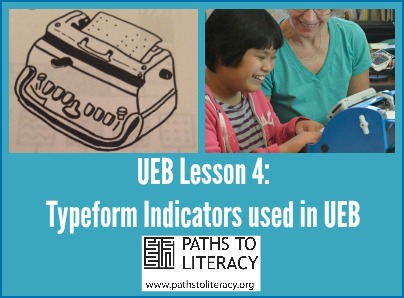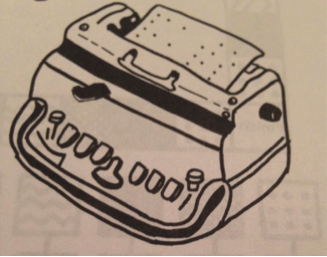UEB Lesson 4: Typeform Indicators used in UEB
Submitted by Suzanne Cappiello on Aug 11, 2015

This post is the fourth in a series of lessons on teaching students who are braille readers to make the transition from EBAE (English Braille American Edition) to UEB (Unified English Braille). All lessons are by Catherine Summ and Suzanne Cappiello, who both work as Education Consultants for the Department of Rehabilitative Services (DORS-BESB) in CT. See the full UEB Curriculum with all lessons
Goal:
The student will be able to identify typeform indicators used in UEB: Italics, Underline, Bold.
For an explanation of the changes refer to the handout “Overview of Changes from Current Literary Braille to Unified English Braille” authored by Braille Authority of North America, March 2013, www.brailleauthority.org. See Italics, Bold, Underline. Refer to the UEB manual for a full explanation of the braille code.
These indicators have prefixes as well as roots. The prefix indicates the type of attribute, and the root indicates how far it extends. For the “begin” indicators, the prefixes are easy to remember:
Italics: dots 4-6, just like the current italics
Underline: dots 4-5-6, like the underscore in computer braille
Bold: dots 4-5, a little like a letter b (b for bold) but on the other side of the cell
The roots are the same for these indicators:
Letter: dots 2-3
Word: dot 2
Passage: dots: 2-3-4-6
Procedure:
Teacher prepares the list below in braille. The list below contain typeforms using italics, boldface, and underline. Have the student read the sentences below. Then have the students mark the typeform indicators and write which indicator is being used after the sentence. (Teacher should leave room for answers after each braille word, phrase, or sentence.
- Softly
- good night
- uninteresting
- Sally
- double trouble
- The teenager sang very loudly.
- The children love to watch Nickelodeon .
- The book Of Mice and Men is controversial in high schools today.
- He said, things are not always what they seem.
- Every Friday at 8 0”clock my family watches TeeVee.
Writing Practice

Dictate sentences to students using the typeforms for italics, underline, and boldface. Add your own.
- Come over tomorrow and we can watch the World Series.
- I very much enjoy Ballroom dance on Saturday nights.
- The baby is comforted by her mother singing lullabies to her at nap time.
- Do you like to watch Rachel Ray on the Food Network?
- Grandpa went to the clinic to see his doctor at 9 o’clock.
Assessment:
Teacher dictates the following sentences using the typeforms italics, underline, and boldface. Add your own.
Teacher compiles a spreadsheet for each student to document progress and compile data.

- The Sandy Award was given to her by a prestigious foundation.
- Sally sings so loud in the shower.
- Freddy likes to play the tuba in the Wildcats Marching Band.
- He needed to go into the office for interviews.
- I am quite disappointed in your actions toward your instructor.
- The custodian was excited to get a raise AND a promotion all in the same day.
- The Boy Scouts of America is one of the nation’s largest organizations.
- Her friends called her Double Trouble as her nickname.
- He complained to the restaurant owner that his meal was cold.
- Summer time by the beach is so much fun.
Educational Activity and Game:
Double Trouble: Materials: brailler, word and phrase cards, die, kitchen timer
Prepare a set of 50-100 word and phrase cards (i.e., double trouble, loud, etc.) using italics, boldface, and underline.
- Players roll die to determine the dealer. This player will be the one to read and dictate to other players.
- Each player takes a sheet of paper and inserts it into the braille writer.
- Word and phrase cards are placed face down to begin the “draw” deck.
- The dealer sets the timer to 3-5 minutes, takes a card from the draw deck and reads the word or phrase using the description of whether the word or phrase has any italics, bold, or underlined component.
- The players write the words or phrases on their paper.
- When the timer goes off, the players take out their papers and exchange with other students to correct their work.
- Team decides how many rounds to play.
- Winner is the player with the least amount of corrections.
Click here to download the Duxbury file (courtesy of Karen Carl).
For related lesson, see also: Teaching Ideas for UEB Typeform Indicators.
Attached File(s):


Comments
Thank you so much for this
would like a new cart with UEB
Braille Transcribers and UEB